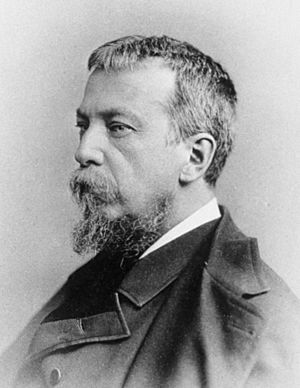Silas Weir Mitchell (physician) facts for kids
Quick facts for kids
Silas Weir Mitchell
|
|
|---|---|
 |
|
| Born | February 15, 1829 |
| Died | January 4, 1914 (aged 84) Philadelphia, Pennsylvania, US
|
| Alma mater | Jefferson Medical College |
| Known for | neurology research |
| Spouse(s) | Mary Cadwalader |
| Relatives | Silas Weir Mitchell (descendant) |
Silas Weir Mitchell (born February 15, 1829 – died January 4, 1914) was an American doctor, scientist, writer, and poet. He is often called the "father of medical neurology". This means he was a very important person in studying the brain and nerves.
Mitchell discovered two painful conditions: causalgia (now called complex regional pain syndrome) and erythromelalgia. He also created a special treatment called the rest cure.
Contents
Early Life and Education
Silas Weir Mitchell was born in Philadelphia, Pennsylvania, on February 15, 1829. His father, John Kearsley Mitchell, was also a famous doctor and writer.
Silas went to the University of Pennsylvania. He then earned his medical degree (MD) from Jefferson Medical College in 1850.
A Career in Medicine and Writing
During the American Civil War, Mitchell helped soldiers with nerve injuries. After the war, he became a specialist in neurology, which is the study of the nervous system.
The Rest Cure Treatment
Mitchell developed a treatment called the "rest cure." This was for people with conditions like neurasthenia (a type of nervous exhaustion) and hysteria. The treatment involved:
- Staying isolated and in bed.
- Eating a special diet, often high in fat and milk.
- Receiving electrotherapy and massage.
People sometimes called this treatment 'Dr Diet and Dr Quiet'.
Medical Discoveries and Terms
Mitchell wrote important medical books. These include Injuries of Nerves and Their Consequences (1872). He also wrote Fat and Blood (1877).
A condition called erythromelalgia is sometimes known as Mitchell's disease because he studied it. He also came up with the term phantom limb. This describes the feeling that an amputated (removed) limb is still there.
Mitchell discovered and treated causalgia. Today, this is known as CRPS. It's a painful condition often seen by hand surgeons. Many consider Mitchell a pioneer of "evidence-based" medicine. This means he used scientific proof in his treatments.
Mitchell's Literary Works
In 1866, Mitchell published a short story called "The Case of George Dedlow." After this, he spent his time on both science and writing.
He wrote about many scientific topics. These included rattlesnake venom and injuries to the nerves. He also wrote about nervous diseases in women.
Mitchell also wrote many books of poetry. He published The Hill of Stones and Other Poems in 1883. He also wrote novels, which made him a leading American author. His historical novels were very popular. Some famous ones include Hugh Wynne (1897) and The Red City (1909).
Famous Patients and Influence
Mitchell's rest cure was used on famous writers. One was Charlotte Perkins Gilman. Her experience with the rest cure inspired her short story "The Yellow Wallpaper." This story showed the negative side of the treatment.
Another writer, Virginia Woolf, also received the rest cure. She wrote about it in her novel Mrs. Dalloway.
Mitchell's work also influenced Sigmund Freud, a famous psychologist. Freud reviewed Mitchell's book on treating nervous conditions. Freud even used some of Mitchell's ideas, like physical relaxation, in his own therapy.
Honors and Awards
Mitchell was highly respected in science and literature. He received honorary degrees from many universities. He was also a member of many important societies.
He was president of the Association of American Physicians in 1887. He also led the American Neurological Association from 1908 to 1909.
The S. Weir Mitchell Award for young researchers is named after him. Even a type of rattlesnake, Crotalus mitchellii, was named in his honor.
Personal Life
Silas Weir Mitchell was married twice. His first wife was Mary Middleton Elwyn. They had two sons:
- John Kearsley Mitchell (1859–1917), who also became a neurologist.
- Langdon Elwyn Mitchell (1862–1935), a playwright.
In 1875, he married Mary Cadwalader. She came from a very important family in Philadelphia. This marriage helped him become part of the city's highest social groups. They had one daughter, Marie Gouverneur Cadwalader Mitchell (1876–1898).
Mitchell passed away on January 4, 1914, in Philadelphia. He is buried at The Woodlands Cemetery.
Cultural Contributions
Mitchell helped found The Franklin Inn Club in 1902. This was a club for writers and artists.
He was also a friend and supporter of the artist Thomas Eakins. Mitchell owned one of Eakins's paintings, Whistling for Plover. He even lent furniture for Eakins's paintings.
The artist John Singer Sargent painted two portraits of Mitchell. The sculptor Augustus Saint-Gaudens also created a bronze portrait of him. Mitchell asked Saint-Gaudens to make a monument for his daughter, called The Angel of Purity.
Medical Terms Named After Mitchell
- Weir Mitchell skin – This describes red, shiny, sweaty skin. It is seen when a nerve is partly damaged.
- Weir Mitchell treatment – This is another name for the rest cure. It treats conditions like neurasthenia by using bed rest, good food, massage, and electricity.
- Mitchell's disease – This is another name for erythromelalgia.
- Dorland's Medical Dictionary (1938)
Selected Publications
- Rest in the Treatment of Nervous Disease (1875)
- Fat and Blood: And How to Make Them (1877)
- Fat and Blood: An Essay on the Treatment of Certain Forms of Neurasthenia and Hysteria (1884)
- Researches upon the Venoms of Poisonous Serpents (1886)
- Characteristics (1910)
- Circumstance (1902)
- The Autobiography of a Quack and other stories (1903)
Images for kids
-
Brooklyn Museum
Whistling for Plover (1874)
by Thomas Eakins.



